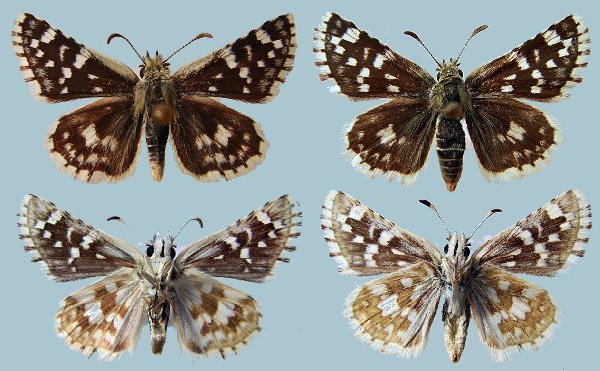Pyrgus scriptura apertorum

Photo Life History: Pyrgus scriptura apertorum
Habitat: Urban-Suburban; (disturbed habitat) Agricultural Areas; Desert Hills & Mountains; Desert Washes
Host Plants: Sida hederacea; Sphaeralcea ambigua; Sphaeralcea coccinea
Suitable Lab Host Plants: Malva neglecta; (Most any mallows will work in the lab.)
How to Find Female Butterflies: Click here.
How to Care for Live Female Butterflies: Click here.
Methods of Female Oviposition: Portable Cages; Potted Plant Sleeves; Small Squat Tub
How to Find Eggs:
How to Hatch Eggs: Consolidate eggs into one container
How to Find Caterpillars in the Field: Look for Skipper Nests. Small checkered skippers nests show quite a bit of small white powder (almost a foam-like appearance) and are quite visibly distinct as compared to the larval nests of the common checkered skipper or large white skipper which use the same mallows. Click here for example. More examples are found in the skipper nests link above or the photo life history link on top of this page.
How to Find Pupae in the Field: Look for Skipper Nests. However, I have not been able to locate pupae in larval nests in the field even though larvae pupate in larval nests under lab conditions. Larvae may wander off plant before pupating in the field.
Caterpillar setups: Open terrariums; Open Bucket; Twin Cup Method;
Larva to Pupa:
Number of Broods per Year: 2-4
Overwintering Stage: pupa
Overwintering Strategies: Your Own Backyard; Refrigerator
Post-Hibernation Strategies: Provide post-diapause pupae with warmer temperatures, long-day photoperiod; and higher humidity. Pupae will emerge in conjunction with the new growth of its larval host plants in the spring.
Avoiding Diapause Techniques: Healthy host plant. It is not difficult to push late-fall feeding larvae through to adult by providing fresh host plant.
Disease Prevention: Change out host plant and remove frass every two to three days.
Emergence: Emergence Container
Field Notes: The biggest key to finding larvae of this skipper is to find areas where the adults fly. Populations can be quite local. Pyrgus scriptura nests are quite unique as compared to Pyrgus communis or Heliopetes ericetorum. Once those differences are recognized, it is not too difficult to find larvae in the field.

